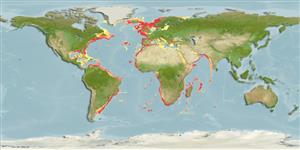>
Perciformes/Scorpaenoidei (Scorpionfishes) >
Sebastidae (Rockfishes, rockcods and thornyheads) > Sebastinae
Etymology: Helicolenus: Greek, helike, -es = spiral + Greek, lenos, -ou = cavity (Ref. 45335).
Environment: milieu / climate zone / depth range / distribution range
Ekologi
laut batidemersal; kisaran kedalaman 50 - 1100 m (Ref. 41452), usually 150 - 600 m (Ref. 84778). Deep-water; 70°N - 46°S
Western Atlantic: Nova Scotia, Canada to Venezuela. Eastern Atlantic: Iceland (Ref. 12462) and Norway to the Mediterranean and the Gulf of Guinea, including Madeira, the Azores, and the Canary Islands; also Walvis Bay, Namibia to Natal, South Africa (Ref. 4313).
Length at first maturity / Size / Weight / umur
Maturity: Lm 32.0 range ? - ? cm
Max length : 50.0 cm TL jantan/; (Ref. 89108); common length : 25.0 cm TL jantan/; (Ref. 4510); Berat maksimum terpublikasi: 1.6 kg (Ref. 40637); Umur maksimum dilaporkan: 43 Tahun (Ref. 41452)
Duri punggung (Keseluruhan (total)) : 12; duri punggung lunak (Keseluruhan (total)) : 12 - 13; Duri dubur: 3; Sirip dubur lunak: 5. Pinkish with faint dusky bars; Y-shaped dark bar between soft dorsal and anal fins (Ref. 4313).
Adults are found in soft bottom areas of the continental shelf and upper slope. They feed on both benthic and pelagic organisms (crustaceans, fishes, cephalopods, and echinoderms) (Ref. 4570). The reproductive mode is a zygoparous form of oviparity, intermediate between oviparity and viviparity (Ref. 36265, 79712). Larvae and juveniles are pelagic (Ref. 4570). Anterolateral glandular grooves with venom gland (Ref. 57406). Sold fresh (Ref. 27121).
The reproductive mode is a zygoparous form of oviparity, intermediate between oviparity and viviparity (Ref. 36265, 79712). Eggs covered with gelatinous material are fertilised in the ovary. Eggs are released into the seabed at various stages of development and larvae assumes a planktonic existence once the gelatinous covering dissolves (Ref. 31150).
Eschmeyer, W.N. and L.J. Dempster, 1990. Scorpaenidae. p. 665-679. In J.C. Quero, J.C. Hureau, C. Karrer, A. Post and L. Saldanha (eds.) Check-list of the fishes of the eastern tropical Atlantic (CLOFETA). JNICT, Lisbon; SEI, Paris; and UNESCO, Paris. Vol. 2. (Ref. 4510)
Status IUCN Red List (Ref. 130435)
penggunaan manusia
Perikanan: komersial
Alat, peralatan
laporan khas
muat turun XML
Sumber internet
Estimates based on models
Preferred temperature (Ref.
123201): 4 - 18.1, mean 10.6 °C (based on 1236 cells).
Phylogenetic diversity index (Ref.
82804): PD
50 = 0.5020 [Uniqueness, from 0.5 = low to 2.0 = high].
Bayesian length-weight: a=0.01047 (0.00911 - 0.01203), b=3.08 (3.04 - 3.12), in cm total length, based on LWR estimates for this species (Ref.
93245).
Trophic level (Ref.
69278): 3.5 ±0.0 se; based on diet studies.
Generation time: 9.6 (7.0 - 14.1) years. Estimated as median ln(3)/K based on 18
growth studies.
Daya lenting (Ref.
120179): Rendah, Waktu penggandaan populasi minimum 4.5 - 14 tahun (K=0.06-0.2; tm=13-16; tmax=43).
Prior r = 0.40, 95% CL = 0.27 - 0.61, Based on 1 data-limited stock assessment.
Fishing Vulnerability (Ref.
59153): High to very high vulnerability (68 of 100).
Nutrients (Ref.
124155): Calcium = 19.7 [7.7, 55.8] mg/100g; Iron = 0.376 [0.168, 0.881] mg/100g; Protein = 16.7 [14.9, 18.7] %; Omega3 = 0.561 [0.214, 1.568] g/100g; Selenium = 21.7 [8.2, 65.8] μg/100g; VitaminA = 14.6 [3.1, 72.9] μg/100g; Zinc = 0.495 [0.271, 0.819] mg/100g (wet weight); based on
nutrient studies.
